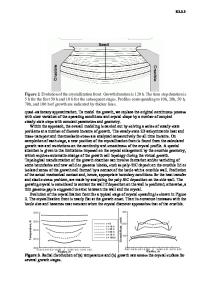Sublimation of Li@C 60
- PDF / 768,571 Bytes
- 7 Pages / 595.276 x 785.197 pts Page_size
- 90 Downloads / 376 Views
THE EUROPEAN PHYSICAL JOURNAL D
Regular Article
Sublimation of Li@C60?,?? Eleanor E.B. Campbell1,2,a , Henry J. Chandler3 , and Renald Schaub3 1 2 3
EaStCHEM and School of Chemistry, University of Edinburgh, David Brewster Rd., Edinburgh EH9 3JF, UK School of Physics, Konkuk University, Seoul 05029, South Korea EaStCHEM and School of Chemistry, University of St. Andrews, St. Andrews KY16 9ST, UK Received 9 March 2020 / Received in final form 16 April 2020 Published online 16 June 2020 c The Author(s) 2020. This article is published with open access at Springerlink.com
Abstract. Experiments that probe the fundamental properties of endohedral fullerenes often require the preparation of molecular beams or thin films of the neutral molecules. It is challenging to cleanly sublime this class of molecules without producing some thermal degradation. We report combined gas phase and scanning tunnelling microscopy studies that probe the thermal decay of commercial [Li+ C60 ]PF− 6 in a quartz ampoule and provide treatment conditions that will allow the sublimation of intact, neutral Li@C60 accompanied by a well-characterised component of neutral C60 . The decay of the material at appropriate temperatures can be modelled with the assumption of a second order decay process in the oven yielding Arrhenius parameters that can predict the ratio of Li@C60 to C60 in the sublimed material.
1 Introduction Endohedral metallo-fullerenes, where at least one metal atom is encapsulated within the fullerene cage, have been the subject of many studies probing their formation, properties and potential applications [1,2]. The most commonly studied metallofullerenes are formed by growing the carbon cage around the metal atoms. In many cases the most energetically favourable cage does not have the same atomic structure as the equivalent empty fullerene cage and it has proved particularly challenging to isolate M@C60 using the conventional arc discharge or laser vapourisation methods [1]. An alternative way to produce C60 metallofullerenes is to implant the metal ion into the already-formed carbon cage. This method was used in early experiments to produce Li@C60 and has the advantage that the cage structure is the same as the well-known, icosahedral empty C60 cage [3]. Experiments on the isolated material showed a higher reactivity compared to C60 with a tendency for the purified material to oligomerise [4]. The production of Li@C60 has recently been upscaled and commercialised by using a plasma implantation technique [5,6]. It was shown that the purified material could be stabilised by forming a hexafluorophosphate salt [6]. The availability of macroscopic amounts of the purified material in the form of the salt has allowed many characterisation studies to be carried out [7]. The Li@C60 molecule is particularly attractive to study from the fundamental
point of view due to the high symmetry of the encapsulating carbon cage and the off-centre position of the encapsulated metal with a relatively strong charge transfer component between the met
Data Loading...











